Almost every company uses a learning and development strategy to boost morale and execute new policies in the organization. It also helps in enhancing knowledge and skills. This reduces the professional gaps and introduces new areas of improvement and to remove those gaps new strategies will be implemented
Q: What is Learning and Development (L&D)?
A: Learning and development (L&D) is the process of gaining new information, skills, and aptitudes that advance one’s professional and personal development. In order to achieve organizational goals, it entails assessing learning needs, devising learning programs, and effectively delivering them.
Q: Why is L&D important for organizations?
A: L&D is important for organizations because it helps to improve the knowledge and skills of employees, leading to increased productivity and efficiency. Also, it contributes to the establishment of a learning and development culture, which can improve employee happiness, retention, and engagement.
Q: What are some common L&D methods?
A: The most popular L&D techniques include simulations, on-the-job training, coaching and mentoring, workshops and seminars, in-class instruction, and e-learning.
Q: How do you measure the effectiveness of L&D programs?
A: The effectiveness of L&D programs can be assessed using a variety of techniques, including pre- and post-training evaluations, participant and manager feedback, behavior change observation, and performance metric analysis.
Q: How can L&D support diversity and inclusion in the workplace?
A: By providing training programs that encourage cultural understanding and sensitivity, unconscious bias training, and other diversity-related issues, L&D can enhance diversity and inclusion in the workplace. Also, it can promote an inclusive and respectful workplace atmosphere by giving employees the chance to express their experiences and viewpoints.
Q: How can technology be used in L&D?
A: Many forms of technology, including e-learning, virtual classrooms, webinars, mobile learning, gamification, and social learning, can be employed in Learning and Development. It may provide employees with flexible and accessible learning opportunities, and also enable employers to manage and analyze learning data more effectively.
Q: What are some emerging trends in L&D?
A: Microlearning, personalized learning, gamification, virtual and augmented reality, and artificial intelligence are some of the new trends in learning and development. The demand for more adaptable, interesting, and efficient learning solutions that can adapt to the changing demands of both people and businesses is what is driving these trends. HurixDigital leverages these cutting-edge trends to deliver innovative, scalable, and engaging learning solutions that enhance workforce development and drive business success.



